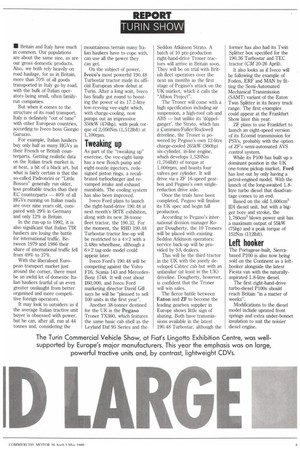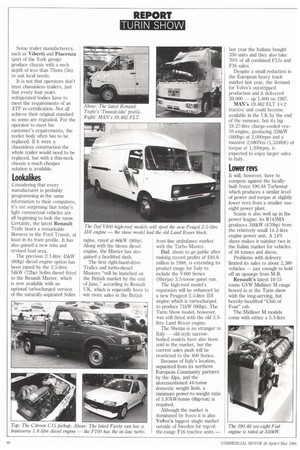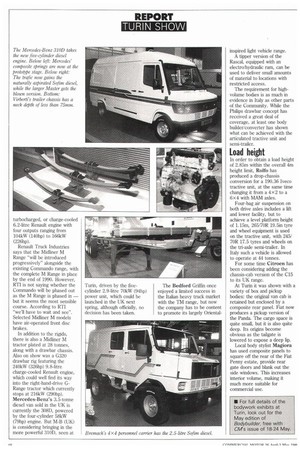REPORT
Page 47

Page 48

Page 50

If you've noticed an error in this article please click here to report it so we can fix it.
TURIN SHOW
• Britain and Italy have much in common. Our populations are about the same size, as are our gross domestic products. Also, we both rely heavily on road haulage, for as in Britain, more than 70% of all goods transported in Italy go by road, with the bulk of Italian operators being small, often familyrun companies.
But when it comes to the structure of its road transport, Italy is definitely "out of tune" with other European countries, according to lveco boss Giorgio Garuzzo.
For example, Italian hauliers buy only half as many HGVs as their French or British counterparts. Getting realistic data on the Italian truck market is, at best, a bit of a black art, but what is fairly certain is that the so-called Padroncini or "Little Bosses" generally run older, less profitable trucks than their EC counterparts — 40% of all HGVs running on Italian roads are over nine years old, compared with 29% in Germany and only 12% in Britain.
In the run-up to 1992, it is also significant that Italian TIR hauliers are losing the battle for international traffic. Between 1979 and 1986 their share of international traffic fell from 49% to 37%.
With the liberalised European transport market just around the corner, there must be an awful lot of domestic Italian hauliers fearful of an even greater onslaught from better organised and more competitive foreign operators.
It may look to outsiders as if the average Italian tractive unit buyer is obsessed with power, but he can, after all, run at 44 tonnes and, considering the mountainous terrain many Italian hauliers have to cope with, can use all the power they can get.
On the subject of power, Iveco's most powerful 190.48 Turbostar tractor made its official European show debut at Turin. After a long wait, Iveco has finally got round to boosting the power of its 17.2-litre low-revving vee-eight which, with charge-cooling, now pumps out an impressive 350kW (476hp), with peak torque of 2,050Nm (1,512Ibft) at 1,10Orpm.
As part of the "tweakirig up" exercise, the vee-eight lump has a new Bosch pump and eight-nozzle injectors, redesigned piston rings, a recallbrated turbocharger and revamped intake and exhaust manifolds. The cooling system has also been improved.
Iveco Ford plans to launch the right-hand-drive 190.48 at next month's IRTE exhibition, along with its new 38-tonne fleet tractor, the 190.32. For the moment, the RHD 190.48 Turbostar tractor line-up will be restricted to a 4 x2 with a 3.48m wheelbase, although a 6 x 2 tag-axle model could appear later.
lveco Ford's 190.48 will he competing against the Volvo F16, Scania 143 and MercedesBenz 1748. It will cost about £60,000, and lveco Ford marketing director David Gill says he will be "pleased to sell 100 units in the first year".
Another 38-tonner destined for the UK is the Pegaso Ironer TX360, which features the same basic cab shell as the Leyland Daf 95 Series and the Seddon Atkinson Strato. A batch of 10 pre-production right-hand-drive Ironer tractors will arrive in Britain soon. They will be on trial with British fleet operators over the next six months as the first stage of Pegaso's attack on the UK market, which it calls the "Albion Project".
The Troner will come with a high specification including air suspension, a high-roof cab and ABS — but unlike its 'doppelganger', the Strato, which has a Cummins/Fuller/Rockwell ctriveline, the Ironer is powered by Pegaso's own 12-litre charge-cooled 265kW (360hp) six-cylinder, in-line engine, which develops 1,520Nm (1,7041bft) of torque at 1,000rpm, and boasts four valves per cylinder. It will drive via a ZF 16-speed gearbox and Pegaso's own singlereduction drive axle.
Once the trials have been completed, Pegaso will fmalise its UK spec and begin full production.
According to Pegaso's international division manager Roger Dougherty, the 10 Troners will be placed with existing Seddon Atkinson operators: service back-up will be provided by SA dealers.
This will be the third tractor in the UK with the jointly developed Cabtec cab but with an unfamiliar (at least in the UK) driveline. Dougherty, however, is confident that the Troner will win sales.
The fierce battle between Eaton and ZF to become the leading gearbox supplier in Europe shows little sign of abating. Both have transmissions available in the latest 190.48 Turbostar, although the former has also had its Twin Splitter box specified for the 190.36 Turbostar and TEC tractor (CM 20-26 April).
It also looks as if Iveco will be following the example of Foden, ERF and MAN by fitting the Semi-Automated Mechanical Transmission (SAMT) variant of the Eaton Twin Splitter in its heavy truck range. The first examples could appear at the Frankfurt Show later this year.
ZF plans to use Frankfurt to launch an eight-speed version of its Ecomid transmission for PSVs, probably with the option of ZF's semi-automated AVS control system.
While its P100 has built up a dominant position in the UK one-tonne pickup market, Ford has lost out by only having a petrol-engined model. With the launch of the long-awaited 1.8litre turbo diesel that disadvantage comes to an end. Based on the old 1,600cm3 WI diesel unit, but with a bigger bore and stroke, the 1,760cm3 blown power unit has a maximum output of 55kW (75hp) and a peak torque of 152Nm (112Ibft).
The Portugese-built, Sierrabased P100 is also now being sold on the Continent as a lefthooker alongside the latest Fiesta van with the naturallyaspirated 1.8-litre diesel.
The first right-hand-drive turbo-diesel P100s should reach Britain "in a matter of weeks".
Modifications to the diesel model include uprated front springs and extra under-bonnet insulation to suit the noisier diesel engine. Some trailer manufacturers, such as Viberti and Piacenza (part of the York group) produce chassis with a neck depth of less than 75mm (3in) to suit local needs.
It is not that operators don't trust chassisless trailers, just that every four years refrigerated bodies have to meet the requirements of an ATP re-certification. Not all achieve their original standard so some are regraded. For the operator to meet his customer's requirements, the reefer body often has to be replaced. If it were a chassisless construction the whole trailer would need to be replaced, but with a thin-neck chassis a much cheaper solution is available.
lookalikes
Considering that every manufacturer is probably programming in the same information to their computers, it's not surprising that today's light commercial vehicles are all beginning to look the same. Certainly, the latest Renault Trafic bears a remarkable likeness to the Ford Transit, at least in its front profile. It has also gained a new trim and revised load area.
The previous 2.1-litre 45kW (60hp) diesel engine option has been joined by the 2.5-litre 54kW (72hp) Sofim diesel fitted to the Renault Master, which is now available with an optional turbocharged version of the naturally-aspirated Sofim ngine, rated at 66kW (88hp). Along with the blown diesel engine, the Master has also gained a facelifted dash.
The first right-hand-drive Trafics and turbo-diesel Masters "will he launched on the British market by the end of June," according to Renault UK, which is especially keen to win more sales in the British front-line ambulance market with the Turbo Master.
Daf, about to go public after making record profits of £40.6 million in 1988, is extending its product range for Italy to include the V400 Series (Sherpa) 3.5-tonne panel van.
The high-roof model's reputation will be enhanced by a new Peugeot 2.5-litre IDI engine which is turbocharged to produce 71kW (96hp). The Turin Show model, however, was still fitted with the old 2.5litre Land Rover engine.
The Sherpa is no stranger to Italy — old-style narrowbodied models have also been sold in the market, but the current sales push will be restricted to the 400 Series.
Because of Italy's location, separated from its northern European Community partners by the Alps, and the aforementioned 44-torme domestic weight limit, a minimum power-to-weight ratio of 5.87kW/tonne (Shp/ton) is required.
Although the market is dominated by lveco it is also Volvo's biggest single market outside of Sweden for top-ofthe-range F16 tractive units —
last year the Italians bought 350 units and they also take 70% of all combined F12s and F16 sales.
Despite a small reduction in the European heavy truck market last year, the demand for Volvo's outstripped production and it delivered 39,000 — up 1,600 on 1987.
MAN's 19.462 FLT 4x2 tractive unit could become available in the UK by the end of the summer, but its big 18.27-litre charge-cooled vee10 engine, producing 338kW (460hp) at 2,000rpm and a massive 2,080Nni (1,5341bft) of torque at 1,200rpm, is expected to enjoy larger sales in Italy.
Lower revs
It will, however, have to compete against the locallybuilt Iveco 190.48 Turbostar which produces a similar level of power and torque at slightly lower revs from a smaller veeeight power plant.
Scania is also well up in the power league: its RI43MA produces 346kW (470hp) from the relatively small 14.2-litre engine power unit. A 14% share makes it number two in the Italian market for vehicles of 16 tonnes and above.
Problems with delivery limited its sales to about 2,380 vehicles — just enough to hold off an upsurge from M-B.
Renault's latest 10-15 tonne GVW Midliner M range bowed in at the Turin show with the long-serving, but heavily-facelifted "Club of Four" cab.
The Midliner M models come with either a 5,5-litre turbocharged, or charge-cooled 6.2-litre Renault engine with four outputs ranging from 104kW (140hp) to 166kW (226hp).
Renault Truck Industries says that the Midliner M Range "will be introduced progressively" alongside the existing Commando range, with the complete M Range in place by the end of 1990. However, Rh I is not saying whether the Commando will be phased out as the M Range is phased in — but it seems the most sensible course. According to RTI "we'll have to wait and see". Selected Midliner M models have air-operated front disc brakes.
In addition to the rigids, there is also a Midliner M tractor plated at 28 tonnes, along with a drawbar chassis. Also on show was a G320 drawbar rig featuring the 240kW (326hp) 9.8-litre charge-cooled Renault engine, which could well find its way into the right-hand-drive GRange tractor which currently stops at 216kW (290hp). Mercedes-Benz's 3.5-tonne diesel van sold in the UK is currently the 308D, powered by the four-cylinder 58kW (79hp) engine. But M-B (UK) is considering bringing in the more powerful 310D, seen at
Turin, driven by the fivecylinder 2.9-litre 70kW (94hp) power unit, which could be launched in the UK next spring, although officially, no decision has been taken.
The Bedford Griffin once enjoyed a limited success in the Italian heavy truck market with the TM range, but now the company has to be content to promote its largely Oriental
inspired light vehicle range.
A tipper version of the Rascal, equipped with an electro/hydraulic ram, can be used to deliver small amounts of material to locations with restricted access.
The requirement for highvolume bodies is as much in evidence in Italy as other parts of the Community. While the Philips drawbar concept has received a great deal of coverage, at least one body builder/converter has shown what can be achieved with the articulated tractive unit and semi-trailer.
Load height
In order to obtain a load height of 2.85m within the overall 4m height limit, Rolfo has produced a drop-chassis conversion for a 190.36 lveco tractive unit, at the same time changing it from a 4x2 to a 6x4 with MAM axles.
Four-bag air suspension on both drive axles includes a lift and lower facility, but to achieve a level platform height of 1. 15m, 265/70R 19.5in tyre and wheel equipment is used on the tractive unit, with 245/ 70R 17.5 tyres and wheels on the tri-axle semi-trailer. In Italy such a vehicle is allowed to operate at 44 tonnes.
For some time Citroen has been considering adding the chassis-cab version of the C15 to its UK range.
At Turin it was shown with a variety of box and pickup bodies: the original van cab is retained but enclosed by a composite rear panel. Fiat now produces a pickup version of the Panda. The cargo space is quite small, but it is also quite deep. Its origins become obvious as the tailgate is lowered to expose a deep lip.
Local body stylist Magiora has used composite panels to square off the rear of the Fiat Penny estate, provide rear gate doors and blank out the side windows. This increases interior volume, making it much more suitable for commercial use.
MI For full details of the bodywork exhibits at Turin, look out for the May edition of Bodybuilder, free with CA/is issue of 18-24 May.




































































































































































































